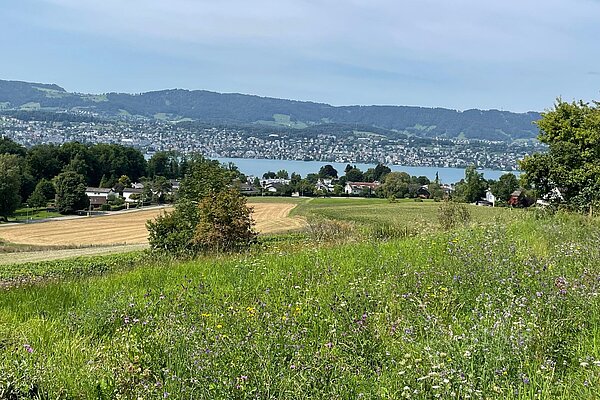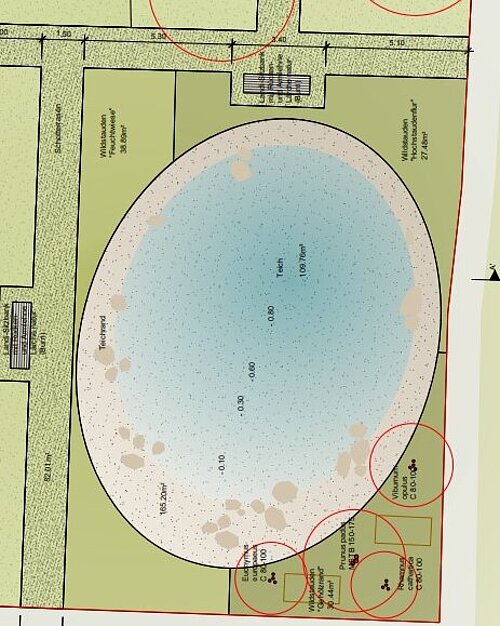Our new nature areas –
promoting biodiversity together
Enabling biodiversity to recover and flourish

Who can become a project partner of 'Get Nature Positive'?
To offset the impact of sealed areas, we collaborate with dedicated project partners who establish and maintain new nature areas in the long term. These include:
- farmers and tenants
- foresters and forest owners
- nature networks and nature conservation organizations
- communities that want to enhance open spacesn
Get Nature Positive offers its project partners expert advice and support and covers all costs for creating the new nature areas.
Are you planing a nature project?
We offer:
- Intensive consulting, project support, and monitoring by Get Nature Positive.
- Financing of project initiation (materials and labor) and, where necessary, maintenance (initial growth care) for the first two years.
- A private law contract will be negotiated to secure the land for 25 years
Requirements for nature projects:
- A minimum area of 5000 m² per project partner. Justified exceptions are possible.
- Improvement of at least one biotope value compared to the initial state.
- The minimum habitat quality required is biotope value 4. The project must meet the requirements for ecological compensation ("ökologischer Ausgleich" according to Swiss law).
Project partners must be willing to engage in regular exchange and monitoring with Get Nature Positive.
Facts and figures on land suitable for new nature areas
Our nature areas are created on agricultureal land, in forests, through the expansion of nature reserves, and in large infrastructure projects. The potential is enormous!
Agriculture:
- Extensive meadows: 32,930 hectares with quality level I could be converted into quality level II areas, which are much more valuable for nature (Valley and hill region, Agrarbericht 2024).
- Hedges with a total length of approx. 2,200 km could be converted from quality level I to level II (Valley and hill region, Agrarbericht 2024).
Forest:
- Of the 1.2 million ha of forest, only about 1% is currently protected as natural forest (Naturwald). A target value of 10%, or an additional 100,000 ha, would be reasonable.
Railway embankments:
- 15,350 hectares of extensive green spaces could be ecologically upgraded and maintained (Konzept naturschutzgerechter Böschungsunterhalt SBB, 2009).
In Switzerland, approximately 1,760 hectares of land are newly sealed each year. The potential new nature areas listed here could offset all newly sealed areas over the next 85 years.
If, in addition, half of the green spaces created as part of new construction projects were designed to be ecologically valuable (Get Nature Positive Premium requirement), around 15,000 hectares of new natural areas would be created in urban areas by 2050.
Our nature projects
We ensure the quality and sustainability of the new nature areas through:
- long-term private-sector contracts with responsible parties (owners, managers, municipalities, etc.).
- regular exchanges with our partners as part of a monitoring program.
Nature makes you happy
The loss of biodiversity is now considered one of the most pressing environmental issues—even more serious than climate change. The World Economic Forum's Global Risks Report 2025 ranks biodiversity loss as the second-biggest long-term risk for the next ten years.
At the same time, nature plays a central role in our well-being:
According to a major SRG opinion poll conducted in 2023 (Link), most people in Switzerland would like to spend more time in nature, as this would contribute most to their happiness in life.
If you asked nature whether it was happy...
... the result would be less clear-cut.
- Half of all habitats are under threat (FOEN).
- One third of all animal and plant species in Switzerland are endangered (FOEN).
- Sealed surfaces in Switzerland have increased by 40% within 33 years (BFS).
- Around 1,760 hectares (17.6 km²) of soil are sealed in Switzerland every year (BFS), which is equivalent to around 2,571 football pitches. This equates to approximately half a square metre of soil being lost every second.
- 95% of dry meadows (FOEN) and 90% of moorland has disappeared since 1900 (FOEN).
We could continue with this list. However, we would much rather focus on the opportunities we have, together with you, to reverse this trend and protect and promote biodiversity. It's in our best interests!
![[Translate to English:] Plan Naturfläche Wasenbächli Hammer Cham ZG](/fileadmin/_processed_/9/8/csm_Plan_Naturfl%C3%A4che_Wasenb%C3%A4chli_Hammer_00b081c72a.jpeg)
![[Translate to English:] Plan Naturfläche Eizmoos Cham ZG](/fileadmin/_processed_/e/6/csm_Plan_Naturfl%C3%A4che_Eizmoos_f36e920a74.jpeg)
